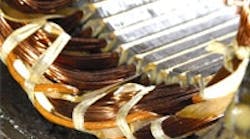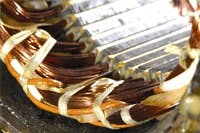Efficiency of large motors has been increasing for some years. Now, the U.S. Department of Energy (DOE) is considering mandating higher energy-efficiency requirements for small motors. Motors with greater energy efficiency generally cost more than standard motors of equivalent power. This forces motor users to justify the higher initial cost by means of energy savings accrued during the projected life of the motor.
Motor efficiency is defined as the power output divided by the power input. Subtracting the output power from the input power reveals the machine losses. Therefore, the only way to improve efficiency is to reduce these losses.
So, how do motor manufacturers accomplish that? The National Electrical Manufacturers’ Association (NEMA) standard MG1 says that motors can be tested in several ways following Institute of Electrical and Electronic Engineers (IEEE) standard 112 for polyphase motors. Method 112B allows the manufacturer to separate the losses into categories that include:
|
View more motor efficiency content on PlantServices.com |
- Stator copper losses (I2R) that are a result of current in the windings
- Rotor copper losses (I2R) that are a result of current in the rotor
- Core losses that result from magnetizing the steel. These consist of hysteresis and eddy current losses.
- Friction and windage losses that result from bearing friction and the rotor moving the air inside the motor
- Stray load losses that are defined as losses not accounted for elsewhere.
Stator copper loss
[pullquote]Two ways to reduce stator copper losses are by reducing the electric current flowing through the stator and reducing the winding’s ohmic resistance. The magnetic flux produced in the motor’s stator is driven across an air gap to interact with the rotor conductors. This produces a rotor field that interacts with the main field flux and produces the output power.
A certain amount of current is needed to magnetize the stator steel while the balance produces the output power. The efficiency is raised by reducing the magnetizing current. Motor manufacturers accomplished this by increasing the steel stack length (core length).
The copper losses also can be reduced by reducing the winding resistance. This requires a larger wire size. The slot sizes are fixed for a given stator lamination configuration, so there’s a limit on how much wire can be inserted into it. It would be possible to exceed the slot size limit only by redesigning the lamination to increase the slot size. This requires new stamping dies, which can cost hundreds of thousands of dollars.
Rotor and core losses
One can reduce rotor losses by decreasing the rotor’s ohmic resistance. Motor manufacturers increase the rotor end ring, redesign the rotor slot and use copper rotor conductors instead of aluminum. All these options cost money. There’s a lower limit on rotor resistance because as it drops, the full-load speed increases. Changing end rings is a relatively small expense compared to redesigning the rotor slot and converting to copper conductors, but it adds expense nonetheless.
Core loss can be lowered by reducing the magnetic flux density and by changing the steel type. The hysteresis component of core loss is determined by the characteristics of the steel when magnetized in one direction then demagnetized and remagnetized in the other direction. This is largely a function of the steel type and processing.
The eddy current component of the core loss results from the changing magnetic field inducing voltages and currents in the steel core. It’s a function of the steel type, thickness, and processing and can be reduced by upgrading the steel type and using thinner laminations. This alloy is more costly and more laminations are needed for a given core length to produce the same power.
Motor lamination alloys are usually known in the industry by their M Grade number. For instance, a common steel used in motors is 24-ga. M56. This steel has a core loss of around 5 watts per pound. The so-called “better steels,” such as 29 ga. M19, exhibit a core loss of about 2 W per pound under similar operating conditions. Using M19 steel in place of M56 steel requires more steel to produce the same output power. And, the number of laminations for a given core length increases. Both factors increase the motor cost.
Friction and windage loss
These losses have two major components: bearing friction and cooling system losses. Bearing friction is a function of the bearing size, lubricant and the approach used to seal the bearing. Because most bearings are chosen as a function of the load and application, it leaves little room for change, other than using better grease and seals.
Windage loss results from having to move cooling air through the motor. The cooling fan constitutes the largest part of the loss. Motors have cooling fans to maintain temperatures within the limitations of the insulation system. The fan can be removed if it’s possible to control the temperature within safe limits in other ways. In most cases, however, some means of cooling is required. Improving the entire cooling system to reduce air flow losses is a reasonable goal. Improved cooling systems usually require the addition of baffles and venturis, which add cost.
Stray load loss
Stray load losses are those not accounted for in the other loss categories. They’ve been the topic of many papers and much discussion over the years. There’s evidence that some stray load losses are caused by eddy currents in the tooth tips and rotor surface, as well as rotor bars being shorted to the lamination steel. These losses can be reduced somewhat by changing the rotor manufacturing methods. But, these additional operations, too, lead to increased costs.
Reducing motor losses will, by definition, increase efficiency. The losses are easily identified and quantified using IEEE methods. There’s a labor or material cost associated with each loss-reduction measure. Improved motor efficiency is achieved by improved materials, additional materials and improved processing. All these cost money and drive up the cost to consumers. Motor manufacturers balance these costs against the improved efficiency benefits and the cost to the consumer.
William H. Yeadon, P.E., is the owner of Yeadon Energy Systems in Iron River, Mich. (www.yeadoninc.com). Contact him at [email protected] and (906) 265-7937.

